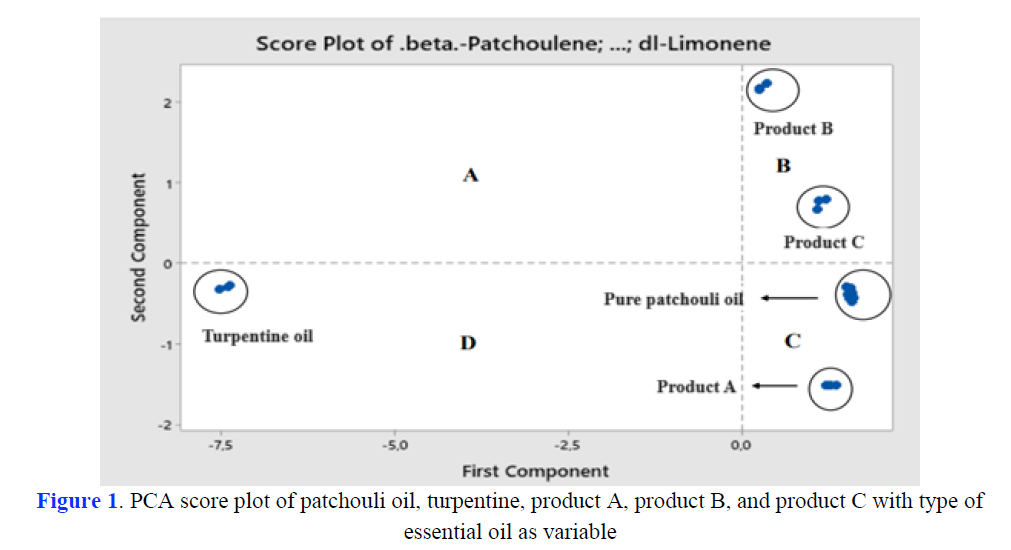Main Article Content
Abstract
Adulteration in patchouli oil trade is an ancient practice, where additional substances like turpentine oil are added to increase volume and odor. Therefore, this research aimed to determine the composition of patchouli oil, considering variations in growing regions and potential adulteration in the products available in the market. The analysis was carried out using the Gas Chromatography-Mass Spectrormetry (GC-MS) method with a Principal Component Analysis (PCA) chemometric combination for authentication. The sample obtained from Bantul, Kulon Progo, and Purworejo was isolated through steam and water distillation. Subsequently, it was tested in accordance with SNI standard 06-2385-2006 and analyzed using GC-MS. The results were compared to the products on the market and processed using multivariate chemometric, namely PCA with Minitab 19 software. GC-MS analysis showed the presence of various compounds contained in the oil, including alcohol, alpha-guaiene, beta-humulene, seychellene, trans-caryophyllene, neoalloocimene, and beta-patchoulene. The combination of GC-MS and PCA chemometrics was able to distinguish patchouli oil from others and the products available on the market. PCA chemometric analysis showed that the patchouli oil from various growing regions had the same chemical components as essential oil. Furthermore, PCA chemometric analysis of market products also showed similar results but varied significantly from turpentine oil. This showed that the patchouli oil product available on the market did not contain turpentine oil.
Keywords
Article Details

This work is licensed under a Creative Commons Attribution-NonCommercial 4.0 International License.
References
- Akbar, A. (2020). Peran Pemerintah Dalam Memaksimalkan Minyak Nilam. Al-Ijtimai: International Journal of Government and Social Science, 5(2), 193–202.
- Anggraeni, Y., Nisa’, F., & Betha, O. S. (2020). Karakteristik Fisik dan Aktivitas Antibakteri Sabun Cair Minyak Nilam (Pogostemon cablin Benth.) yang Berbasis Surfaktan Sodium Lauril Eter Sulfat. Jurnal Kefarmasian Indonesia, 1–10. https://doi.org/10.22435/jki.v10i1.499
- Ardianto, A., & Humaida, S. (2020). Pengaruh cara pengeringan nilam (Pogostemon cablin Benth.) pada penyulingan terhadap hasil minyak nilam. Agriprima, Journal of Applied Agricultural Sciences, 4(1), 34–44.
- Bazakos, C., Spaniolas, S., & Kalaitzis, P. (2016). DNA-based approaches for traceability and authentication of olive oil. IntechOpen Publisher: London, UK.
- David, G. W. (2005). Analisis Farmasi. Edisi Kedua, EGC, Jakarta.
- Gandjar, I. G., & Rohman, A. (2007). Kimia farmasi analisis. Yogyakarta: Pustaka Pelajar, 224, 228.
- Guntarti, A., Rohman, A., Martono, S., & Yuswanto, A. (2016). Autentikasi Lemak Celeng Dengan Kromatografi Gas-Spektroskopi Massa Yang Dikombinasikan Kemometrika PCA (Principle Component Analysis). Rakernas Dan Pertemuan Ilmiah Tahunan Ikatan Apoteker Indonesia, 57–63.
- Hariyani, H., Widaryanto, E., & Herlina, N. (2015). Pengaruh umur panen terhadap rendemen dan kualitas minyak atsiri tanaman nilam (Pogostemon cablin Benth.). Brawijaya University.
- Ma’mun, M. (2003). Identifikasi Pemalsuan Minyak Nilam Di Rantai Tataniaga.
- Manalu, R. A., Patria, A., & Rohaya, S. (2019). Peningkatan Mutu Minyak Nilam (Pogostemon cablin) dalam Proses Pemurnian Minyak Nilam Aceh Jaya dan Aceh Selatan dengan Metode Kompleksometri. Jurnal Ilmiah Mahasiswa Pertanian, 4(4), 310–318.
- Manurung, T. B. (2003). Usaha Pengolahan dan Perdagangan Minyak Atsiri Indonesia dan Permasalahannya dalam Menghadapi Era Perdagangan Global. Sosialisasi Temu Usaha Peningkatan Mutu Bahan Olah Industri Minyak Atsiri. Jakarta: Industri Kimia Agro Dan Hasil Hutan.
- Purwakusumah, E. D., Rafi, M., Safitri, U. D., Nurcholis, W., & Adzkiya, M. A. Z. (2014). Identifikasi dan autentikasi jahe merah menggunakan kombinasi spektroskopi FTIR dan kemometrik. Agritech, 34(1), 82–87.
- Ramayanti, D., Harmawan, T., & Fajri, R. (2021). Analisis Kadar Patchouli Alcohol Menggunakan Gas Chromatography–Mass Spectrometry (GC–MS) pada Pemurnian Minyak Nilam (Pogostemon cablin B.) Aceh Tamiang dengan Nanomontmorillonite. Al Kimiya: Jurnal Ilmu Kimia Dan Terapan, 8(2), 68–74.
- Rohman, A. (2014). Spektroskopi Inframerah dan Kemometrika untuk Analisis Farmasi. Pustaka Belajar.
- Rohman, A. (2017). Physico-chemical properties, biological activities and authentication of cod liver oil. Journal of Food and Pharmaceutical Sciences, 5(1), 1–7.
- Schaduw, J., Pojoh, J. A., & Djabar, T. O. (2012). Isolasi dan identifikasi minyak atsiri pada daun nilam (Pogostemon cablin Benth). Jurnal Ilmiah Farmasi (JIF), 3(2), 61–63.
- Sim, C. O., Hamdan, M. R., Ismail, Z., & Ahmad, M. N. (2004). Assessment of herbal medicines by chemometrics–assisted interpretation of FTIR spectra. J Analytica Chimica Acta, 1, 14.
- Standar Nasional Indonesia. (2006). Minyak nilam. Badan Standarisasi Nasional.
- Sufriadi, E., Meilina, H., Munawar, A. A., & Idroes, R. (2021). Fourier Transformed Infrared (FTIR) spectroscopy analysis of patchouli essential oils based on different geographical area in Aceh. IOP Conf. Ser.: Mater. Sci. Eng., 1087, 012067.
- Tauhana, T. A. (2008). Menyuling Minyak atsiri. Yogyakarta: Citra Aji Parama, 3, 26–28.
- Trifilieff, E. (1980). Isolation of the postulated precursor of nor-patchoulenol in patchouli Leaves. Phytochemistry, 19(11), 2467.
- Wu, H., Li, J., Jia, Y., Xiao, Z., Li, P., Xie, Y., Zhang, A., Liu, R., Ren, Z., & Zhao, M. (2019). Essential Oil Extracted from Cymbopogon Citronella Leaves by Supercritical Carbon Dioxide: Antioxidant and Antimicrobial Activities. Journal of Analytical Methods in Chemistry.
- Zhao, Z., Lu, J., Leung, K., Chan, C. L., & Jiang, Z.-H. (2005). Determination of patchoulic alcohol in herba pogostemonis by GC-MS-MS. Chemical and Pharmaceutical Bulletin, 53(7), 856–860.
